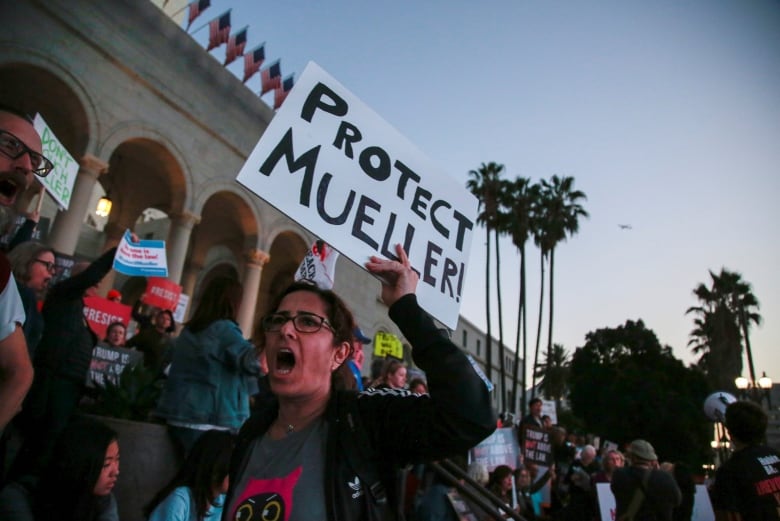Barr's summary of Mueller report was a brilliant PR tactic that changed the conversation: Keith Boag
Brief document allows the president to take a victory lap — but big questions remain about Russia probe

One week after special counsel Robert Mueller handed in his work to the U.S. attorney general, it still seems impossible for the U.S. Justice Department to give a straight answer to the most elementary question: How many pages is it?
The thickness detail is touchy, because the report is apparently a tome — more than 300 pages, sources told the New York Times — and the possibility that the weight of it might also imply the gravity of it could lead to suspicions about the four-page recapitulation Attorney General William Barr presented to Congress on the weekend.
Even the Trump-friendly Fox News channel acknowledged that. As its house legal analyst, Judge Andrew Napolitano, told viewers Wednesday, a thick report likely means "there is something in there that the Democrats and opponents of the president want to see," and if they see it, "they'll make hay out of it."
'Multiple offers'
For example, tucked away in Barr's letter is a hint of the untold stories that are in the full report: The Trump campaign received "multiple offers" of help from "Russian-affiliated individuals," it says. Multiple offers.
However many offers "multiple offers" is, it's certainly more than the one we know about that was made at Trump Tower in June 2016.
What kind of help was it? Were all the offers rebuffed, or did they just not pan out? Who knew about them? How were the offers made? Was the Kremlin involved? Did Trump know about them and conceal them? And if he did, did the Russians use that knowledge as kompromat against him? How? Would U.S. intelligence have benefited from knowing about all of this at the time? Did they?

As Trump's lawyer Rudy Giuliani has often said, collusion is not a crime. So, it will be up to Americans to decide whether a presidential campaign that received multiple offers of help from foreign actors scheming to undermine the U.S. election was colluding with the perpetrators when it kept that a secret — if that's what Mueller tells us happened.
The meaning of 'most'
Then there's the obstruction case. Barr's letter says Mueller investigated actions by the president that might constitute obstruction — "most of which have been the subject of public reporting."
Barr seems to enlist the word "most" as a double agent. It suggests the actions Mueller examined are old news while really what it says is the opposite: The Mueller report details actions by Trump that Mueller considered could be construed as obstruction — actions we still don't know about.
At the very least, congressional Democrats will want to know what the new evidence of obstruction is to see whether they agree with Barr's assessment that it is not sufficient to prosecute. They are already mindful that obstruction of justice was part of the articles of impeachment in the cases of both President Richard Nixon and President Bill Clinton.

When you consider everything we do know about the Trump-Russia story — the consistent pattern of lies from so many in Trump's circle, Trump's own lies about his Moscow development project, campaign manager Paul Manafort's lies and ties to Russian oligarchs and his sharing of campaign intelligence with a Kremlin-connected Russian, the Trump Tower meeting arranged explicitly as part of Russia's help for the Trump campaign, the indictments, the plea deals, etc. — it's hard not to marvel at how brazenly disingenuous the Barr letter's summary is.
But as a public relations tactic, it was brilliant. It changed the entire conversation for at least a news cycle or two, as the president took a victory lap and the mainstream punditocracy gave Trump what it considered his due. Republicans openly plotted their revenge and promised to investigate Democrats and the so-called deep state to find out how the whole mess got started.
It did not go unnoticed, though, that it was Trump and the Republicans who chose to suddenly change the subject when they turned their attention to trying, again, to repeal the Affordable Care Act.
The memo
When the history of all this is written, the Barr chapter will begin with how shrewdly he manoeuvred his way to the centre of the action. In June 2018, from the comfort of his private legal practice and apparently on his own initiative, he wrote a 19-page memo to Deputy Attorney General Rod Rosenstein. (Barr had been attorney general in the presidency of George H.W. Bush, so he knew how to access the system.)
The memo argued that the president could not obstruct justice in the way that Barr assumed Mueller was approaching the obstruction question. It further argued that Trump should not agree to an interrogation by Mueller.

The memo found its way into the hands of Trump's legal team at a time when the president was already fed up with his then attorney general, Jeff Sessions. One assumes they were impressed by what they read.
The critical moment
We know what happened soon after: Sessions was out, Barr was in, and the Mueller investigation wound down. The critical moment came when Mueller decided he would not make a determination that Trump obstructed justice, even though there was evidence on both sides of that question.
It's hard not to see how this was the moment Barr had prepared himself for when he wrote his memo. He stepped in and took Trump out of the danger zone.
But who would have guessed that he would cap it all with such a cleverly crafted and brilliantly timed letter that minimized the whole drama?

